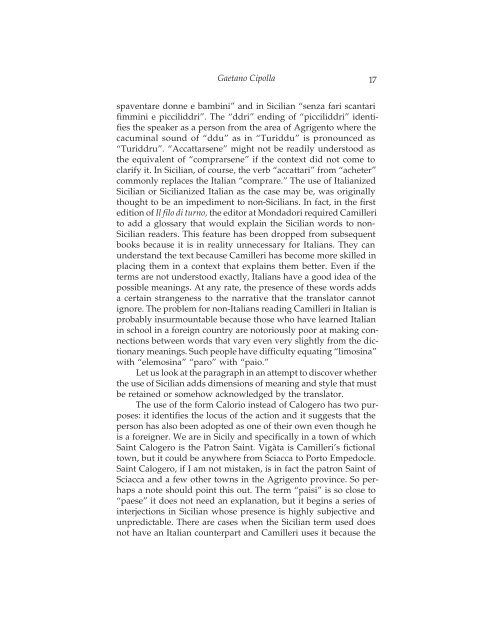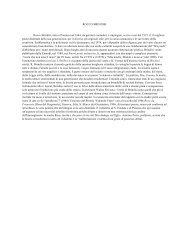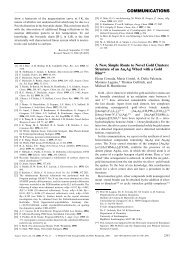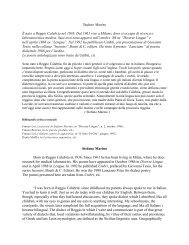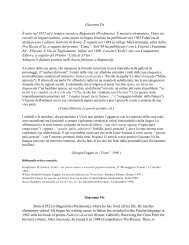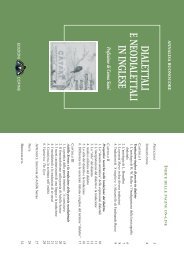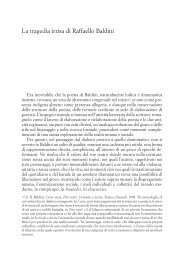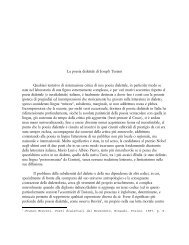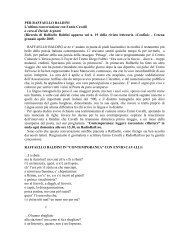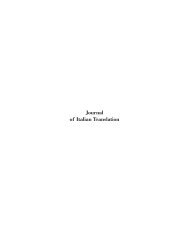Journal of Italian Translation
Journal of Italian Translation
Journal of Italian Translation
Create successful ePaper yourself
Turn your PDF publications into a flip-book with our unique Google optimized e-Paper software.
Gaetano Cipolla<br />
spaventare donne e bambini” and in Sicilian “senza fari scantari<br />
fimmini e picciliddri”. The “ddri” ending <strong>of</strong> “picciliddri” identifies<br />
the speaker as a person from the area <strong>of</strong> Agrigento where the<br />
cacuminal sound <strong>of</strong> “ddu” as in “Turiddu” is pronounced as<br />
“Turiddru”. “Accattarsene” might not be readily understood as<br />
the equivalent <strong>of</strong> “comprarsene” if the context did not come to<br />
clarify it. In Sicilian, <strong>of</strong> course, the verb “accattari” from “acheter”<br />
commonly replaces the <strong>Italian</strong> “comprare.” The use <strong>of</strong> <strong>Italian</strong>ized<br />
Sicilian or Sicilianized <strong>Italian</strong> as the case may be, was originally<br />
thought to be an impediment to non-Sicilians. In fact, in the first<br />
edition <strong>of</strong> Il filo di turno, the editor at Mondadori required Camilleri<br />
to add a glossary that would explain the Sicilian words to non-<br />
Sicilian readers. This feature has been dropped from subsequent<br />
books because it is in reality unnecessary for <strong>Italian</strong>s. They can<br />
understand the text because Camilleri has become more skilled in<br />
placing them in a context that explains them better. Even if the<br />
terms are not understood exactly, <strong>Italian</strong>s have a good idea <strong>of</strong> the<br />
possible meanings. At any rate, the presence <strong>of</strong> these words adds<br />
a certain strangeness to the narrative that the translator cannot<br />
ignore. The problem for non-<strong>Italian</strong>s reading Camilleri in <strong>Italian</strong> is<br />
probably insurmountable because those who have learned <strong>Italian</strong><br />
in school in a foreign country are notoriously poor at making connections<br />
between words that vary even very slightly from the dictionary<br />
meanings. Such people have difficulty equating “limosina”<br />
with “elemosina” “paro” with “paio.”<br />
Let us look at the paragraph in an attempt to discover whether<br />
the use <strong>of</strong> Sicilian adds dimensions <strong>of</strong> meaning and style that must<br />
be retained or somehow acknowledged by the translator.<br />
The use <strong>of</strong> the form Calorio instead <strong>of</strong> Calogero has two purposes:<br />
it identifies the locus <strong>of</strong> the action and it suggests that the<br />
person has also been adopted as one <strong>of</strong> their own even though he<br />
is a foreigner. We are in Sicily and specifically in a town <strong>of</strong> which<br />
Saint Calogero is the Patron Saint. Vigàta is Camilleri’s fictional<br />
town, but it could be anywhere from Sciacca to Porto Empedocle.<br />
Saint Calogero, if I am not mistaken, is in fact the patron Saint <strong>of</strong><br />
Sciacca and a few other towns in the Agrigento province. So perhaps<br />
a note should point this out. The term “paisi” is so close to<br />
“paese” it does not need an explanation, but it begins a series <strong>of</strong><br />
interjections in Sicilian whose presence is highly subjective and<br />
unpredictable. There are cases when the Sicilian term used does<br />
not have an <strong>Italian</strong> counterpart and Camilleri uses it because the<br />
17


